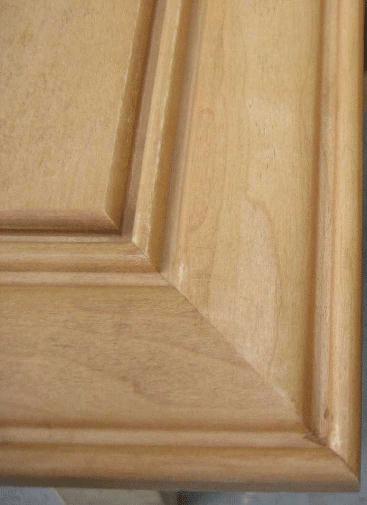Tips for a Non-Blotchy Maple and Birch Finish
To your tool-kit for avoiding blotchiness in hard-to-stain woods, add this: "solvent soaking." September 26, 2006
Question
I have a client asking for a maple kitchen, but stained to a medium brown tone. For this project (not a big money one), I'm going to outsource my fronts from Walzcraft and have them do the stain and finish. Since I'm a cabinetmaker, not a pro finisher, I'm wary of a wiping stain on maple due to the blotchy outcome, and am also not a big fan of the spray-no-wipe option because it tends to obscure the grain. I'm wondering if I should suggest birch instead of maple, hoping that I can do a wiping stain on birch, avoid some of maple's tendency to blotch, and retain the look of maple since they're close in grain pattern. In your experience with birch less blotchy? I realize I might be better off suggesting a darker wood - say, white oak or even walnut - and then just clear coat it. Any thoughts are greatly appreciated.
Forum Responses
(Finishing Forum)
From contributor M:
In my experience, birch plywood blotches just as bad as maple. I've heard folks argue both directions. Point blank, they both blotch.
Your best shot will be, in my opinion, to simply test your stain on a long sample (a 4"X3ft piece of hardwood will give you a good idea of how it will blotch). Sand the whole mess to 150 (using a small finish sander if possible, rather than an aggressive random-orbit) and then finish off by wrapping some 150 around a sponge and sand with the grain to remove all swirl marks. Then stain.
Note that some may suggest to you to use washcoats: this will eliminate blotching almost completely. It will also eliminate the darker colors (giving you a weak color) and keep pigments like gilsonite from getting into the grain and "popping" it like you seem to want (as most of us do).
From contributor C:
I always use a spray-on dye stain on maple, cherry and similar woods. The dye also gives the wood a beautiful chatoyance. Works great and does not obscure the grain. Brings it out more, if anything.
From contributor S:
You are correct - spraying a wiping stain will give a very muddy finish. Dye is the only way for me. It is completely transparent and you can get any color there is with great depth and no blotching or dark end grain.
From contributor A:
Find a quality finisher that will pre-stain the wood before applying the stain. We pre-stain all the stuff that goes though our shop (mostly maple) and it all comes out gorgeous with no blotches anywhere. This might cost a bit more, but it will really make the maple look like it should. All woods that blotch should be pre-stained, conditioned and well sanded before applying a wiping stain. And I agree that a spray-no-wipe tends to pigment out the grain far too much.
From contributor L:
My preferred strategy for dealing with these issues is to do a weak stain (usually I prefer to add body to the stain by diluting with clear stain base or similar products, rather than washcoating) and then finishing the tinting with a lightly pigmented clear coat. This tends to get the drama of the wood's grain while limiting the contrasts to artistically successful levels. I think that maple is generally easier to work with than birch. In fact, I can't think of any other common wood which can achieve such a wide range of stained colors and looks. It is a favorite of mine. Common problems with birch are torn (slivered) veneers and dark streaks. Birch is also somewhat more coarsely grained than maple and suffers more from raised grain issues when using water based products (which I often favor).
From contributor X:
Pigmented wood stains were not intended to be sprayed, brushed, or wiped on, unless they are wiped off because they have large particles. Dyes have much smaller particles, and if sprayed with the proper technique, will not blotch.
The pre-conditioner could be almost any one of the drying oils, or the clear base for stains or glazes, which basically is going to add a thin skin to the wood. This film will prevent the stain from penetrating into the wood, which is one way how to prevent blotching. Glue sizing, boiled linseed oil, solvent soaking, gel stains - basically a heavy bodied drying oil or solvent soaking with pigments. There is a lot of information on blotching. Just do a search here, and you will find it.
From the original questioner:
Thanks. It seems to be the case that the door suppliers (Walzcraft, Portadoor, etc.) don't do a conditioning step and/or don't use dye over pigment because their blotching is quite pronounced. Are you aware of a door supplier who does a particularly good job with their stain and finish? Or am I expecting too much from a company that's really in the business of woodwork?
From contributor R:
To minimize the blotchy effect on maple, try wiping the door down with paint thinner and then staining it. This will also prevent the end grain from absorbing too much stain. Overall, you will get a much more consistent color. This is just another process you might call a stain conditioning.
From contributor X:
Only the old timers know about solvent soaking. The proper solvent floods the wood, and then being that the wood can only absorb so much liquid, the stain cannot penetrate the wood. Be sure you use the right solvent for whichever type of stain you will be using.
As with all new techniques, make some samples.
From contributor O:
Could you not send the cabinet parts out with the doors? That way they would match the doors.
